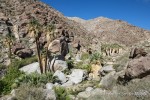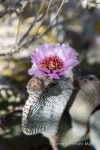Since our last post Team Gritty zig-zagged west from the dry heat of Arizona to the dry heat of Southern California. We spent a few breezy days (30-plus mph gusts!) exploring some of the hiking trails at Anza Borrego Desert State Park. It’s located within the Colorado Desert and is the largest state park in California. But that’s not the only superlative—at 600,000 acres, it’s the largest desert park and the second largest park in the continental US. Anza Borrego boasts mountains, canyons, oases (complete with the endangered California fan palm, Washingtonia filifera), natural springs, streams, hundreds of miles of dirt roads, 110 miles of hiking trails, a great variety of fauna including endangered Desert bighorn sheep, a terrific visitor center, and so much more.
Early one morning Team Gritty hiked the Borrego Palm Canyon Trail to the palm oasis, stopping occasionally to look for bighorn sheep. A ranger at the Nature Center said one of the best ways to spot a bighorn sheep is to stop, remain still, and slowly scan the mountainsides for movement. She also said the sheep would probably notice us well before we saw them and they’d be watching us. We didn’t see any of them on our hike, but felt as though we were being watched — sheep or . . . ?
In the distance we spotted the tall native palms waving as the wind blew hard down the canyon. About a quarter mile from the oasis we came upon the stream and watched birds flit from catclaw bushes to mesquite trees and listened to them chatter loudly to each other.
We crossed the stream bed, rounded a few boulders, and stopped to make photos by a waterfall before hiking up into the tall palm grove. The waterfall ran lightly, without any significant spring rain, water cascaded down boulders, but not with any force. The lack of rain also subdued the anticipated spring wild flower show. Specimens bloomed throughout the desert but on a much smaller scale than in past years. We hiked into the palm grotto—a clearing under the palm trees—and paused to admire the tall trees and stream running nearby.
- Palo verde in bloom
- Team Gritty at Anza Borrego Desert State Park, California
- Occotillo flowers
- Ancient morteros, or grinding holes, along the Palm Canyon Trail
- Stream runs through the native palm oasis
- Honey Mesquite (Prosopis pubescens) with blooming yellow flowers along the Palm Canyon Trail
- Sunbathing lizard
- Waterfall at the native palm oasis
- Native palm oasis
- Native palm oasis
- Flowering Beavertail cactus
- Roadrunner under blooming palo verde
We ate breakfast on a rock slab under giant swaying palms, and spied a lizard watching us as he performed a few push-ups before hurrying on his way. We took the Alternate Trail Route back to our campsite, an excellent way to view the canyon from a different perspective.
Anza Borrego Desert State Park is an amazing and diverse state park, and although our visit was a short one, we look forward to returning. Perhaps next time we’ll see bighorn sheep . . . before they see us!
Next up: Dust storms at Death Valley National Park — stay tuned. . . .















